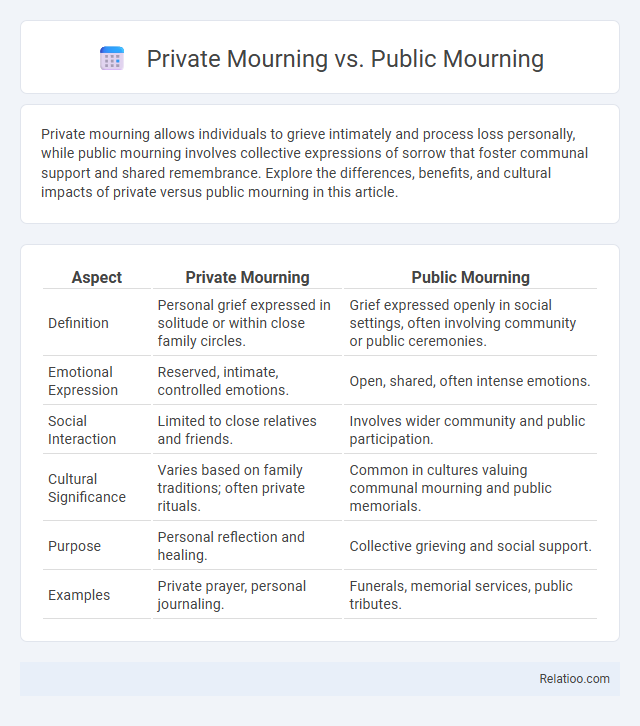Private mourning allows individuals to grieve intimately and process loss personally, while public mourning involves collective expressions of sorrow that foster communal support and shared remembrance. Explore the differences, benefits, and cultural impacts of private versus public mourning in this article.
Table of Comparison
| Aspect | Private Mourning | Public Mourning |
|---|---|---|
| Definition | Personal grief expressed in solitude or within close family circles. | Grief expressed openly in social settings, often involving community or public ceremonies. |
| Emotional Expression | Reserved, intimate, controlled emotions. | Open, shared, often intense emotions. |
| Social Interaction | Limited to close relatives and friends. | Involves wider community and public participation. |
| Cultural Significance | Varies based on family traditions; often private rituals. | Common in cultures valuing communal mourning and public memorials. |
| Purpose | Personal reflection and healing. | Collective grieving and social support. |
| Examples | Private prayer, personal journaling. | Funerals, memorial services, public tributes. |
Understanding Private Mourning: An Intimate Grief
Private mourning involves a deeply personal and intimate process of grieving that allows you to reflect on loss away from external influences and public attention. Unlike public mourning, which often includes collective rituals, ceremonies, or social expressions of grief, private mourning centers on your individual emotions and memories. Understanding private mourning helps in recognizing the importance of solitude and personal space for emotional healing during times of sorrow.
Exploring Public Mourning: Collective Expressions of Loss
Public mourning reveals the collective expressions of loss that unify communities through shared rituals, memorials, and social media tributes. It transforms individual grief into a communal experience, often marked by ceremonies, vigils, and public displays of remembrance that reinforce social bonds and cultural identity. Contrasting with private mourning's introspective nature, public mourning provides a platform for collective healing and acknowledgment of significant losses.
Cultural Perspectives on Mourning Practices
Private mourning emphasizes personal grief rituals within intimate settings, reflecting individual and family customs deeply rooted in cultural values. Public mourning involves communal expressions of loss, such as memorial services and shared ceremonies, fostering collective identity and social solidarity across cultures. Mourning practices vary globally, with some cultures prioritizing emotional restraint and others encouraging open displays of sorrow, highlighting diverse cultural perspectives on honoring the deceased.
Psychological Impact of Private Mourning
Private mourning allows individuals to process grief intimately, fostering emotional regulation and personal reflection, which can mitigate feelings of overwhelm and anxiety. Unlike public mourning, which involves communal rituals and shared expressions of sorrow, private mourning emphasizes solitude and introspection, often leading to a deeper understanding of personal loss. Psychological benefits include reduced external pressures and enhanced coping mechanisms, contributing to healthier long-term emotional adjustment.
The Role of Social Media in Public Mourning
Social media platforms transform public mourning by enabling real-time sharing of grief and collective memory, amplifying emotional support across global audiences. Unlike private mourning, which occurs in intimate settings, public mourning facilitated by social media creates virtual spaces for communal expression and solidarity, often shaping public narratives around loss. This digital amplifying effect allows for widespread participation, making mourning a social, interconnected phenomenon influenced by viral posts, hashtags, and multimedia tributes.
Benefits and Challenges of Public Mourning
Public mourning fosters collective healing by creating spaces for shared grief, which can alleviate feelings of isolation and build community support. However, it may also expose mourners to unwanted public scrutiny and impose social expectations that complicate personal emotional processes. Balancing the therapeutic benefits of communal remembrance with the need for private reflection remains a central challenge in public mourning practices.
Privacy and Vulnerability in Times of Loss
Private mourning involves a deeply personal and introspective grieving process where individuals seek solitude to cope with loss, preserving privacy as a shield against emotional exposure. Public mourning, often expressed through communal rituals or social media, creates a shared space for collective vulnerability, allowing individuals to find support but also risking emotional overexposure. Balancing privacy and vulnerability during mourning is crucial for emotional healing, as too much public openness may hinder personal reflection, while excessive privacy can limit social support networks.
Rituals and Traditions: Private vs Public Memorials
Private mourning rituals often involve intimate ceremonies such as lighting candles, personal prayers, or creating memory spaces at home to honor the deceased, emphasizing personal reflection and emotional processing. Public mourning, by contrast, includes community gatherings, funerals, or memorial services where collective grief is expressed through shared traditions like eulogies, floral tributes, and moments of silence. Your choice between private and public memorials shapes how grief is experienced, balancing personal solace with societal support mechanisms rooted in cultural or religious customs.
Navigating Grief: Choosing Your Mourning Path
Navigating grief involves understanding the distinctions between private mourning, public mourning, and general mourning processes to choose your path effectively. Private mourning allows for personal reflection and intimate expressions of loss, while public mourning incorporates communal support and shared rituals that can foster collective healing. Your choice depends on comfort levels, cultural norms, and emotional needs during the grieving period.
Bridging the Gap: Supporting All Forms of Bereavement
Private mourning allows individuals to process grief intimately, while public mourning fosters community support and collective healing. Mourning practices vary across cultures, emphasizing personal and societal needs during bereavement. Bridging the gap between private and public mourning ensures your grief is acknowledged and supported in ways that honor both personal reflection and communal connection.

Infographic: Private Mourning vs Public Mourning
 relatioo.com
relatioo.com